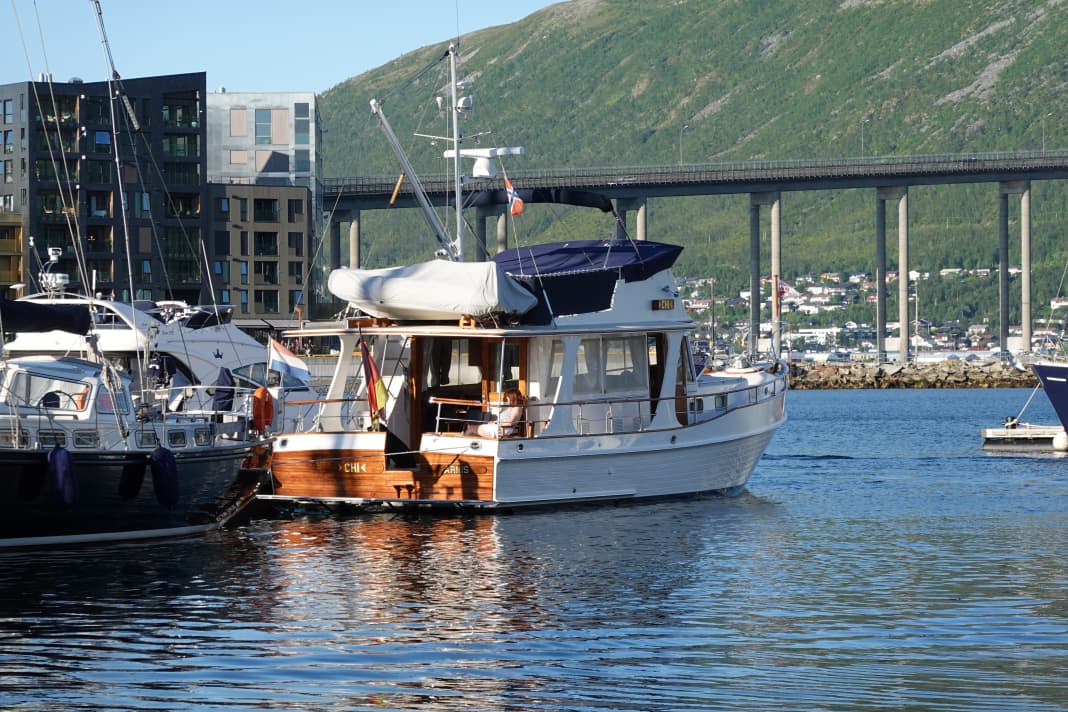Journey: A summer in the Arctic Ocean - from Hammerfest to the Trollfjord
Boote Redaktion
· 09.02.2024






A text by Markus Gehrlein
Today is 27 June 2023, we have been underway for five weeks and reached our destination yesterday with a visit to the North Cape. We are leaving Hammerfest on a southerly course. The Arctic Voyager is anchored outside the harbour. An LNG tanker waiting to take on liquefied natural gas. Not far away is the largest liquefied natural gas plant in Europe at the time, which went into operation in 2007. Gas from the Barents Sea is converted into LNG here. We have decided to take the outward route for our return journey. We are initially planning an extensive visit to Tromsø, a detour to Harstad and onwards through the Raftsund to the Trollfjord. We want to arrive in Svolvær in the Lofoten Islands in just over a week.
It hasn't been dark for over three weeks now."
The weather has been mostly favourable so far and we have had good conditions for a safe journey. Today, too, the Arctic Ocean welcomes us after leaving the harbour with a gentle swell from the north-east, which allows us to run dry before the wind.
Our destination for the day is about 50 miles south of Hammerfest on the 70th parallel, about 700 kilometres north of the Arctic Circle. It is a very sheltered bay that has been in the family for more than 100 years. It used to be an important trading centre for dried fish. The guest house at the campsite is very busy and a few German voices can be heard. There is a new jetty where we are the only guests to find a comfortable berth. The small bay has a white beach and crystal-clear turquoise water. Once again, we have found a little paradise that we will remember for a long time to come.
The wind has picked up a little for the next few days. White crests accompany our course. The wind here in the far north is predominantly from the north to north-east at this time of year. What has often been a problem for us on northerly courses is now working in our favour. The aft sea allows us to make fast progress and our boat runs smoothly through the sea without windscreen wipers.
On 29 June we reach Tromsø, the largest city in the north of Norway with 78,000 inhabitants. The harbour is well frequented by sailors. On the jetty you can hear Belgian, Dutch, French and English voices as well as Norwegian. A German sailing yacht from Kappeln is also moored in the harbour. For us, with its home port of Arnis, a direct neighbour. The three sailors have even circumnavigated the North Cape with their small yacht "Mutsch". Most of the foreign boats have spent the winter here and, like us, are now heading south towards home. Tromsø is also a good choice for a crew change. We spend the next few days shopping and exploring the town. We visit the Ice Sea Cathedral, the Cathedral Church - one of Norway's largest wooden churches - and pay a visit to the "Polaria" Arctic Adventure Centre.
Strong currents in Rystraumen and Raftsund
On 1 July, we leave the harbour together with the sailing yacht "Mutsch". The favourable tidal current in Tromsø Sound allows us to reach the narrow strait of Rystraumen just in time for high tide. Due to the strong currents that occur here at high or low tide, we recommend passing through at high or low tide. As the Straumsfjord to the west of Ryøy is considerably deeper and also wider, the water forces its way through the narrow passage at high speed when the tide changes.
We moored for the night in Harstad on Norway's largest island, Hinnøya. Unfortunately, there is only a floating jetty here, which can only offer moderate protection as a breakwater in the prevailing winds from the north-east. After a very restless night, we leave the island early. Another highlight of our journey awaits us. We want to sail through the Raftsund, which is known for its strong currents, and visit the Trollfjord in the southern part. We pass through the narrow gorges of the sound in fantastic weather. Even in the narrower part of the fairway, where currents of up to eight knots can be expected under the right conditions, we can expect a relaxed journey today.
We reach the entrance to the Trollfjord around midday. The approximately 100 metre wide passage is lined by 1000 metre high mountains that rise vertically out of the water. In the rear part of the side arm, which is about a mile long, it becomes much wider so that cruisers and Hurtigruten ships can also turn round there. Luck is once again on our side and we are almost the only guests in the fjord at this time. No RIBs, dreamlike silence. Only when we leave the Trollfjord does a Hurtigruten mail boat pass us at the narrowest point.
On the evening of 4 July, we reach Svolvaer, the largest town in Lofoten with a population of almost 5,000, as planned. On the approach, we are greeted by the "Fisherwoman", a mighty statue on a rock right next to the harbour entrance. Our next stage begins here with an extensive exploration of the Lofoten Islands.

